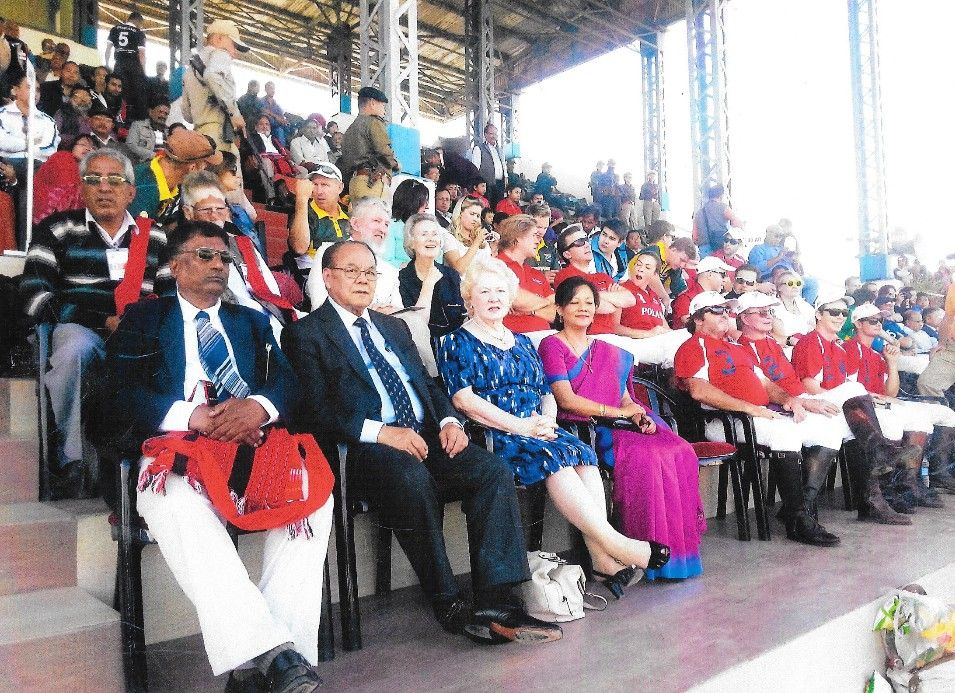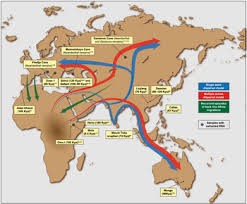Genetic Evidence Of The Origin Of Meiteis From Africa
How Did The First African Meiteis Change To Mongoloid Features
Dr. Irengbam Mohendra Singh *

8th Manipur International Polo Tournament, Imphal, November 2014
Front row from left: second Author, his wife Margaret and his niece Amrita Naorem
The most successful 8th Manipur POLO International Tournament, 2014, organised with military precision, ended on 29 November with a fanfare and razzmatazz. It was also a feat to bring out in a matter of a week a beautiful souvenir brochure by the Editorial Board to commemorate the 150th year of the first game of polo, played by Manipuri players in Calcutta.
While flipping through the pages of the souvenir, I noticed an article by N Thongbam and Y Mohendro, titled the "Manipuries [sic] - Origins, Pre-History and Emergence of a People & Nation". It was brilliantly written and well researched.
To my pleasant surprise, I found that the article contained research material that genetically proved my hypothesis based on empirical evidence that the Meiteis came from Africa and settled in Manipur as a tribal population. In my book The Origin of Meiteis & Meitelon is not a Tibeto-Burman Language, 2009. p98-102) from which an excerpt by Sapam Gita, a journalist, was printed in the Sangai Express on December 2009, I bemoaned that no one has ever studied the Meitei gene while so many researchers have studied non-Meitei tribal genes in the Northeast.
It was, I believed then, because Meiteis are Hindus and thus the tail end of Mayang Aryans in India. The researchers however, overlooked the fact that Indonesian Muslims do not have the same genes as the Arabs, who started the youngest religion of Islam - a monotheistic religion initiated by the Jews, who unlike Hindus, got fed-up with so many gods that were not answering their prayers and thus brought them under one "supreme" god, The God.
It now seems that some researchers including a few Meiteis took up the challenge and have genetically proved that Meiteis indeed, came straight from Africa, like the proto-Australoid Khasis of Meghalaya. They did heretically-based research to trace the origin of Meiteis. Now, the primitive wild speculations that Meiteis are bits and bats of some ethnic community in the south-east Asia should be given a deserved rest.

Genetically decoded population expansion from Africa through India & Manipur
(not copyrighted)
In days gone by, a handful of colonial officials and Christian missionaries wrote ethnographies of the primitive and tribal peoples of Northeast India, in which they always included a guesswork description of their migratory origin. In the absence of history and weight of tradition, these clever clogs searched for probable stories of migration and substituted with a fantasy story. And everyone including the educated ones, swallowed hook, line and sinker.
The origin of the Meiteis is also no exception with no clues has so far been in the wilderness time as we continued to skim the shallow surface of our history. However, the missing link of Meitei evolution will be found in the foreseeable future by decoding the full sequence of DNA of the Meitei genome. That will trace backwards, the Meitei origin from Africa in a specific texture of time, place and circumstance.
The plumbline of truth points to the new genetic evidence that all the tribal populations of Manipur except the Meiteis are related to the Southeast Asian populations and that their language is Tibeto-Burman while Meiteilon remains "unclassified" for over 100 years.
There is also evidence that the arrival of Tibeto-Burman speaking Mongoloids to Manipur was possibly around 1,000 BCE, if we were to believe Gangumei Kabui's History of Manipur: Pre-Colonial period, Ed 2, 2003, p53). He wrote: "Who were markers of palaeolithic and neolithic culture? The Hoabinhian cultural traits points to the Australoid who migrated to Manipur before the advent of the Tibeto-Burman Mongoloid who followed them around 1000 B.C."
We now know that the arrival of Meiteis was around 20,000 BCE, from the findings of Neolithic tools at Napachik in the Imphal valley.
The Northeast India is now populated by Mongoloid tribes who I understand, mostly speak Tibeto-Burman except the Khasis and the Meiteis, whose Meitei language remains unclassified and being unable to be attached as a branch to the ‘Tibeto-Burman language tree' for over 100 years.
In the search for Meitei origin, using the vehicle of prehistoric science, I find that we need more of imagination in order to build up a framework. Manipur, many thousand years ago, in the Pleistocene Age (About 26 million years to about 11,700 years ago) was a distant very cold region. It is in the northern temperature zone between 230 58' – 940 45'E longitudes and between 230 50' to 250 42N latitudes. This was within the range of the ‘Last Glaciation'.
During the Last Ice Age, about 25,000-20,000 years ago, anatomical change from the original dark, African ancestors to the Mongloloid phenotype occurred, as it did to the Meitei African ancestors because of what is known as "genetic drift" change, which means purely by chance, due to adaptation to the extreme cold. In the usual ‘Natural selection', a change is by differentiated reproductive success.
The Meitei ancestors then, was a tiny population and was thus favourable to the force of ‘drift'. The Meiteis had no interbreeding as there are no fossil records of earlier settlers in Manipur, and thus kept their gene pool unmixed. This supports my hypothesis that Meiteis are indeed, the autochthones of Manipur.
The evidentiary component of the proof that such a force of drift did exist, can be seen in Iceland, which has been settled for only 1,000 years by migrants from Norway, Britain and Ireland. There is a new Icelandic population and language. Many of them are rather short, dark-haired, and dark-eyed, with slight Mongoloid features. That's the reason why people living in the Alaskan peninsula developed Mongloloid features. There is now genetic evidence that Meiteis are the primogenitors of Manipur, proven by the two research papers cited below.
(1) "In 2009, K.N. Saraswathy and colleagues studied the Manipuri population to trace their ancestry. He (sic) adopted DRD2 [...] in DNA analysis and found a high variety [...] among the Meiteis. This finding suggests an admixture of incoming Mongoloid groups [from East Asia] with an already existing proto-Australoid (most primitive human race in Asia). The authors expressed that Manipuri population have diverged from the African population much ahead of other Indian populations coming to northeast India."
(2) Another study: "In 2012, Sapam Yaiphaba and others on the basis of study in mtDNA of the Manipuri population (both tribe and non-tribe) observed that there were strong evidences (sic) of genetic inflow from East Asia with the earliest Mongoloid immigrants into then existing proto-Australoid population in the beginning of human habitation in this region. Occurrence of significant East and Central Asian's diagnostic genes within the Manipuri population and complete absence of it in other Indian population, except for a rare observance in a primitive tribal population of south India."
The first study is referring to the research by KN Saraswathy, Kiranmala N Devi (Meitei), Achoubi Devi Nongthombam (Meitei), Somibabu Kahagengbam (Meitei) and others from the Biochemical and Molecular Anthropology Laboratory, Department of Anthropology, University of Delhi.
These researchers embarked on this study "to test the various oral traditions regarding the peopling of Manipur in that these communities immigrated from China, Tibet, and Burma (Myanmar) during different periods of time (Jacobs, 1990), contributing to the varied cultural heritage of the area in the form of tribal and nontribal groups."
Remarkably, unlike Dr Grierson and Dr Konov, who never set foot in Manipur, they did a field study in Manipur. "A total of 1142 random blood samples were collected from 625 males and 517 females, aged 35–75 years who were unrelated up to first cousin. The participants belonged to the Meitei community living in four valley districts of Manipur, India: Imphal East, Imphal West, Thoubal and Bishnupur districts."
They concluded that "Manipuri [Meitei] populations are distant from each other and genetically very far from the populations of other regions of northeast India (Dutta et al 2003, Kumar 2004). This suggests the varied times of migrations, routes, and ancestries for the people of northeast Indian region. PCO [principle coordinate] analysis indicates the inflow of genes from East Asia to Manipur and also admixture with already existing ethnic elements."
Perhaps the odd reader of my book/article, will recall that I highlighted that Meiteis are a distinct tribe with no common origin with any other tribes in Manipur or in the whole of the Northeast.
The researchers continued: "Though the present study is not exhaustive enough to comment on the various evolutionary histories, it is likely that the population movement from mainland India to East Asia through northeast region was difficult, if not impossible.
Indian population in general and Manipur populations in particular are very different and not much influenced by the ethnic, geographic, and linguistic affiliations and are to be dealt as unique breeding isolates with regard to their respective genetic constitutions. This uniqueness could be attributed to their unique mating pattern and strict endogamy. The data generated and documented in the present study may not only be used for evolutionary studies but also can give a platform for community-region-septic association studies related to neuropsychiatric diseases and addictive disorders."
There is also a briefly mentioned account of Manipur having been once under water that corroborates my scientific article - "How was Kangleipak (Manipur) raised from the bottom of the sea" as a cup filled with water, and how the water drained through the naturally occurring three tunnels known as Chingnunghut in southwest Manipur - not the Hindu mythological belief of Shiva making three channels with his Trisul (trident) to drain the water to prepare a place for Radha and Krishna to indulge in their amorous pastimes - known as Ras Lila.
Today, the tectonic vertical uplift of Manipur - a valley cosseted by nine parallel eastern Himalayan ranges along with the whole of Northeast India has been proven by the Geographical Survey of India, Northeastern region (cf. author's book, Points to Ponder).
It's also my firm belief that a time will come in the near future, when some linguists in the Manipur University, are brave enough to challange that Meiteilon does not belong to the Tibeto-Burman family. At the moment, there is a wishy-washy inclusion in the Tibeto-Burman group, with an inveterate epithet "unclassified". Top linguistic specialists of the world are still unable to put Meiteilon in the Tibeto-Burman language tree, despite its many similarities. For the past 100 years Meiteilon has been hovering in the language firmament like a dove holding a twig in its beak, wanting to find her true nest.
* Dr. Irengbam Mohendra Singh wrote this article for e-pao.net
The writer can be contacted at irengbammsingh(AT)gmail(DOT)com and Website: www.drimsingh.co.uk
This article was webcasted on July 17 2019.
* Comments posted by users in this discussion thread and other parts of this site are opinions of the individuals posting them (whose user ID is displayed alongside) and not the views of e-pao.net. We strongly recommend that users exercise responsibility, sensitivity and caution over language while writing your opinions which will be seen and read by other users. Please read a complete Guideline on using comments on this website.







